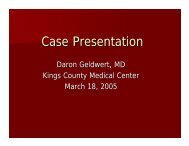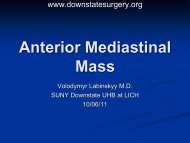Breast Cancer - Department of Surgery at SUNY Downstate Medical ...
Breast Cancer - Department of Surgery at SUNY Downstate Medical ...
Breast Cancer - Department of Surgery at SUNY Downstate Medical ...
You also want an ePaper? Increase the reach of your titles
YUMPU automatically turns print PDFs into web optimized ePapers that Google loves.
Case Present<strong>at</strong>ion• 36 y/o female presented with palpable Rt breast mass.• PMH• 2003- Lt breast infiltr<strong>at</strong>ing ductal carcinoma (T2 N1 M0),ER/PR neg, HER2/neu+1, BRCA neg• Neoadjuvant chemotx, lumpectomy and axillary dissection, RTand adjuvant chemotx.• Premenopausal, G2P2, menarche age 13, first birth <strong>at</strong> age19, +breastfeeding, no OCP/HRT use.• Fam Hx- Mother and sister had breast cancer.
Case Present<strong>at</strong>ion• PE-Rt breast- 2cm mass <strong>at</strong> 9 o’clock.- Lt breast unremarkable. No lymphadenop<strong>at</strong>hy.• Labs WNL• <strong>Breast</strong> U/S- Rt breast 1.6cm mass <strong>at</strong> 9 o’clock andsmaller mass <strong>at</strong> 11 oclocko’clock• Core needle bx- infiltr<strong>at</strong>ing ductal carcinoma,ER/PR neg• CT scan <strong>of</strong> chest, abdomen and pelvis- neg<strong>at</strong>ive• Bone scan- neg<strong>at</strong>ive
Case Present<strong>at</strong>ion• Lumpectomy and Sentinel LN bx was <strong>of</strong>fered.• Pt requested bil<strong>at</strong>eral mastectomies.• Lt simple mastectomy• Rt modified radical mastectomy• Bil<strong>at</strong>eral placement <strong>of</strong> tissue expanders for delayedreconstruction.
Modified Radical Mastectomy• Supine position, ipsil<strong>at</strong>eral armabducted <strong>at</strong> 90°• Transverse elliptical incisionfrom l<strong>at</strong>eral edge <strong>of</strong> sternum tothe midaxillary line.• Skin flaps limits-• Upper- Claviclel• Lower- Inframammary fold• Medial- L<strong>at</strong>eral border <strong>of</strong> sternum• L<strong>at</strong>eral- L<strong>at</strong>issimus i dorsi muscle• <strong>Breast</strong> tissue dissected <strong>of</strong>f theunderlying pectoralis majormuscle• Axillary LN disection.
Modified Radical Mastectomy
Axillary dissection
Case Present<strong>at</strong>ion• Pt was discharged home on POD #1 with JP drains.• P<strong>at</strong>h• Rt breast masses- infiltr<strong>at</strong>ing i ductal carcinoma, high h grade,neg<strong>at</strong>ive margins• Rt Axillary LN- neg<strong>at</strong>ive• Lt breast- no tumor• T3 N0 M0• Pt started on adjuvant chemotx, to be followed by RT.• Tissue expansion uneventful.
Surgical Management<strong>of</strong> fB<strong>Breast</strong> <strong>Cancer</strong>
• <strong>Breast</strong> cancer<strong>Breast</strong> <strong>Cancer</strong>• Most common cancers in women breast, lung and colon ca.• MCC <strong>of</strong> cancer de<strong>at</strong>h among women age 20 to 59 (Jemal et al).• <strong>Breast</strong> <strong>Cancer</strong> past and present.• Halstead (1984)- present<strong>at</strong>ion <strong>of</strong> 50 cases.• 2/3 pt had with locally advanced disease• 60% pts with axillary lymphadenop<strong>at</strong>hy• Rdi Radical mastectomy t prevailed ildf for next t7575yrs.• 1970s – average tumor size <strong>at</strong> present<strong>at</strong>ion –2cm• 1980- ACS- 85% pt presented with stage I or II disease.- 40% pts with axillary lymphadenop<strong>at</strong>hy
Definitions• Radical Mastectomy• Removal <strong>of</strong> breast tissue, pectoralismajor and minor muscles, level I, II andIII axillary LN• Modified Radical Mastectomy• Removal <strong>of</strong> breast tissue, level I and IIaxillary LN• Simple Mastectomy• Removal <strong>of</strong> breast tissue• Subcutaneous or Skin-sparingMastectomy• Removal <strong>of</strong> nipple-areolar lcomplex.
TNM Classific<strong>at</strong>ion for <strong>Breast</strong>• Primary Tumor<strong>Cancer</strong> Staging• Tx- primary tumor cannot be assessed• T0- no evidence <strong>of</strong> primary tumor• Tis- carcinoma in situ• T1- tumor ≤ 2cm• T2-tumor 2 –5 cm• T3- tumor > 5 cm• T4- any size extending to chest wall, inflamm<strong>at</strong>orycarcinoma
TNM Classific<strong>at</strong>ion for <strong>Breast</strong>• Regional lL Lymph hN Nodes<strong>Cancer</strong> Staging• Nx- Nodes cannot be assessed• N0- No node metastasis• N1- Mets 1-3 axillary nodes- Internal mammary (IM) nodes (+p<strong>at</strong>h, not clinically apparent)• N2- Mets 4-9 axillary nodes- Clinically apparent IM nodes• N3- Mets ≥ 10 axillary nodes- Mets IM and axillary nodes- Mets Supraclavicular or infraclavicular nodes
TNM Classific<strong>at</strong>ion for <strong>Breast</strong>• Distant Metastases<strong>Cancer</strong> Staging• Mx- Mets cannot be assessed• M0- No distant metastasis• M1- Distant metastasis
Stage 0TisN0M0Stage IT1N0M0Stage II AT0N1M0T1N1M0T2N0M0Stage II BT2N1M0T3N0M0Stage III AT0N2M0T1N2M0T2N2M0T3N1M0T3N2M0Stage III BT4N0M0T4N1M0T4N2M0Stage III CAny TN3M0Stage IVAny TAny NM1
Stage 0 – TisLobular Carcinoma In Situ (LCIS)• Incidental finding in breast biopsies.• <strong>Breast</strong> cancer risk factor and not a malignancy th<strong>at</strong>progresses locally.ll• Tx• Risk <strong>of</strong> breast cancer development <strong>of</strong> 1 % per year.• Risk affects both breast.• Pt may develop infiltr<strong>at</strong>ing lobular or ductal ca.• Average time for cancer to develop is 10-1515 yrs.• Close follow up - annual mammogram• Chemoprevention• Tamoxifen- 65% risk reduction (Fisher et al).• Prophylactic bil<strong>at</strong>eral mastectomy• Simple or subcutaneous mastectomy.• 90% risk reduction (Hartmann et al).
Stage 0 – TisDuctal Carcinoma In Situ (DCIS)• Present<strong>at</strong>ion- clustered microcalcific<strong>at</strong>ions onmammogram• Management• Simple Mastectomy +/-Sentinel LN bx• Excision i and Radi<strong>at</strong>ion i Therapy (RT)• Excision alone
Stage 0 – TisDuctal Carcinoma In Situ (DCIS)• Simple Mastectomy• Indic<strong>at</strong>ions• Multicentric disease identified on mammogram• Positive margins after reexcision• Unacceptable cosmesis to obtain neg<strong>at</strong>ive margins• P<strong>at</strong>ient’s choice.• Cures 98% p<strong>at</strong>ients• Tx failure rel<strong>at</strong>ed to unrecognized invasive carcinoma.• Invasive carcinoma found in 26% <strong>of</strong> pts having mastectomy forDCIS (Morrow, et al)• Radical tx for a lesion th<strong>at</strong> may not progress to invasivecarcinoma.
Stage 0 – TisDuctal lC Carcinoma In Situ (DCIS)• Excision and Radi<strong>at</strong>ion Therapy (RT) vsExcision alone• Prospective randomized trials• N<strong>at</strong>ional Surgical Adjuvant <strong>Breast</strong> Project (NSABP) B17• European Organiz<strong>at</strong>ion for Research and Tre<strong>at</strong>ment <strong>of</strong> <strong>Cancer</strong> (EORTC)• United Kingdom Trial• RT reduced ipsil<strong>at</strong>eral breast tumor recurrence by 50-60%.• Recurrence with excision 32% vs 16% in excision and RT <strong>at</strong> 10yrs• 50% <strong>of</strong> recurrences were invasive ca in both groups.• No survival lb benefit from RT.
Stage I and Stage II <strong>Breast</strong> <strong>Cancer</strong>• Goal<strong>of</strong>surgicaltx<strong>of</strong> • Remove all clinically evident tumor in the breast andaxillary lymph nodes.• Modified Radical Mastectomy (MRM)• <strong>Breast</strong>-conserving Therapy (BCT)• Excision <strong>of</strong> primary tumor with neg<strong>at</strong>ive margins• Sentinel LN bx• RT
Stage I and Stage II <strong>Breast</strong> <strong>Cancer</strong>• <strong>Breast</strong>-conserving Therapy (BCT)1. Reduce the tumor burden to a microscopic levellikely to be controlled by irradi<strong>at</strong>ion.2. Safely to deliver radi<strong>at</strong>ion therapy.3. Promptly detect local recurrences.
Stage I and Stage II <strong>Breast</strong> <strong>Cancer</strong>• Absolute contraindic<strong>at</strong>ions to BCT• Two or more primary tumors in different breast quadrants.• Persistent positive margins after excision.• Diffuse malignant-appearing appearing microcalcific<strong>at</strong>ions.• Pregnancy is a contraidic<strong>at</strong>ion to RT.• Third trimester- tumor excision, then RT after delivery.• Hx prior RT to breast.• Rel<strong>at</strong>ive contraindic<strong>at</strong>ions to BCT• Multifocal or extensive disease in same breast quadrant.• Unacceptable cosmesis (large tumor in small breast).• Hx scleroderma and active SLE.
BCT vs MRMProspective Randomized TrialsTrialBCTInstitute Gustave Roussy 73SurvivalMRMLocal recurrenceBCTMRM73 65 9 14Milan <strong>Cancer</strong> Institute 42 41 7 2NSABP B06 46 47 14 10NCI 59 58 22 6EORTC 65 66 20 12
Axillary Nodes• Staging procedures• Sentinel lymph node biopsy• Sentinel LN- 1 st LN th<strong>at</strong> receives drainage from the cancer.• Uses lymphazurin blue dye, colloids labeled withradioactive isotope (technetium), or both.• Less morbid than axillary LD dissection.• 10% false-neg<strong>at</strong>ive(Krag, et al).• Contraindic<strong>at</strong>ions• Clinically positive axillary LN• Locally advanced breast cancer• P<strong>at</strong>ient is pregnant or lact<strong>at</strong>ing• Prior axillary surgery.
• Axillary dissection• Indic<strong>at</strong>ionsAxillary Nodes• Pts with positive Sentinel LN bx• Pts with contraindic<strong>at</strong>ons to Sentinel LN bx• Removal <strong>of</strong> level I and level II LN identifiesmetastasis in 98% <strong>of</strong> cases.• Complic<strong>at</strong>ions• Lymphedema• Incidence 6 - 30%, radi<strong>at</strong>ion to axilla increases risk.• Intercostobrachial nerve injury-numbnessnumbness• Long Thoracic nerve injury- Winged scapula defrmity.
Stage III and Stage IV <strong>Breast</strong> <strong>Cancer</strong> –Locally Advanced <strong>Breast</strong> <strong>Cancer</strong>• Initial surgical tre<strong>at</strong>ment• ↑ r<strong>at</strong>e <strong>of</strong> recurrence, poor 5-yr survival, tx failure within 2 yrs <strong>of</strong> dx.• Induction chemotherapy to reduce tumor burden.Mastectomy or LumpectomyChemotherapy, RT and Hormonal Tx
Thank You !

















